In this lengthy series on Arabs, Muslims, and Islam, it’s finally time to focus on the book of Revelation. As noted in my last article, Revelation chapter nine solemnly predicts:
Then the fifth angel sounded: And I saw a star fallen from heaven to the earth. To him was given the key to the bottomless pit. And he opened the bottomless pit, and smoke arose out of the pit like the smoke of a great furnace. So the sun and the air were darkened because of the smoke of the pit. Then out of the smoke locusts came upon the earth. And to them was given power, as the scorpions of the earth have power … The shape of the locusts was like horses prepared for battle. On their heads were crowns of something like gold, and their faces were like the faces of men. They had hair like women’s hair, and their teeth were like lions’ teeth. And they had breastplates likebreastplates of iron, and the sound of their wings was like the sound of chariots with many horses running into battle (Revelation 9:1-3, 7-9, emphasis added).
E.B. Elliot penned one of the most revered Bible commentaries on the book of Revelation ever written. The legendary Charles Spurgeon once referred to Elliot’s commentary, called Horae Apocalypticae, as “the standard work.” First published in 1862, Elliot’s commentary reflects the mainstream thoughts of Protestant scholars from the time of John Calvin (1500s) to the 19th century. In his analysis of the fifth and sixth trumpet blasts of Revelation 9, Elliot is exceedingly clear that these prophecies apply to Mohammed and his warriors.
First, let’s notice what Elliot called “the zoology” of the Bible. God often uses animals or plants to represent peoples or nations, and when He does, those plants and animals are geographically specific to the territories that those nations inhabit. For example, God called Israel “a vine” (Psalms 80:8) because her territory was full of vineyards. In Daniel 7, ancient Babylon was represented as “a lion” (Daniel 7:4), Persia as a “bear” (verse 5), and Greece as “a leopard” (verse 6) because lions, bears, and leopards were all well known throughout the mountains, plains, and forests of Babylon, Persia, and Greece.
What about “locusts” and “scorpions”?
One of the ten plagues upon the Egyptians occurred when Moses stretched out his rod and “an east wind brought the locusts” (Exodus 10:13). East of Egypt is Arabia, and its barren land is a notable home for both locusts and scorpions. Thus the application of the prophecy of Revelation 9 to the territory of Arabia makes perfect sense. The biblical zoology fits, as noted by Elliot.
Space doesn’t allow a detailed explanation of every verse in Revelation 9, or of the details of Mohammed’s highly controversial history, but I will cover some highlights, with a bit of background.
In 538 A.D. the eastern Roman Emperor Justinian issued his famous decree giving the Pope total political power in Europe. The papacy was rising in the west, and Christianity was tobogganing into “the Dark Ages.” Idolatry, corruption, immorality, and apostasy teemed everywhere, even inside the professed churches of Jesus Christ.
32 years later, in 570 A.D., Mohammed was born.
Especially after the terrorist attacks on September 11, 2001, the religion of Islam, and especially the character of Mohammed, has been scrutinized like never before. I’ve read many books and posts on this subject, and still have much to learn, yet there’s no doubt that Mohammad was a bold desert warrior who advanced his cause with the sword. Like a ferocious “east wind,” his movement swept across desert sands in the 7th century, and during the short period from 622 A.D. (the official start of Mohammed’s career when he fled Mecca) to 632 A.D., nearly all of Arabia fell under his sway.
Here’s a quick commentary on Revelation 9:
Verse 1: Many commentators have applied the phrase, “a star fallen,” to Satan and Islamic leaders who cruelly served his purposes.
Verse 2: “The bottomless pit” can easily refer to a barren, desolate region, such as the lands of Arabia. The “smoke” that darkened “the sun and the air” has been applied to many of Mohammed’s doctrines that obscure “the sun” (the true light of Jesus Christ, see Rev. 1:16) and “the air” (the fresh air of freedom, see 2 Cor. 3:17).
Verse 3: The “locusts” and “scorpions” have been applied by many Protestant commentators (Calvin, Barnes, Wesley, Spurgeon, Elliot, etc.) to the armies of Mohammed in their wars of conquest.
Verses 4,5: A “command” and “authority” was mysteriously “given” to these ferocious armies only against those without “the seal of God in their foreheads.” In other words, authority was given to them as a scourge against apostate Christianity similar to the authority granted to King Nebuchadnezzar against ancient Israel when she wickedly departed from the ways of God (read Jeremiah 25:8-11).
Verse 5: During the fifth trumpet, Islamic warriors were granted authority for “five months.” Dates for this period vary somewhat, but most Protestant commentators (1500s-1800s) applied the day-for-a-year principle to this prophecy (see Nu. 14:34 and Ezek. 4:6), making this 150 literal years (30 days in a Hebrew month x 5) of aggressive Islamic warfare against Constantinople, the capital city of the eastern Roman Empire. During that period (often dated from 1299-1449 A.D., starting when Ottoman first became “king” – see Rev. 9:11 – over Turkish Islam), the eastern Roman Empire was savagely tormented, but not “kill[ed].” That is, it remained in existence while Constantinople still remained under Eastern Roman control.
Verses 7-9: This symbolism is amazingly accurate in its description of both the appearance and dress of Turkish Muslim warriors. They wore “gold” (gold colored, yellow turbans), had “hair like women’s hair” (it was characteristically long), were extremely ferocious (like “lions teeth”), literally wore “breastplates of iron,” and rode “horses” as they rushed “into battle.”
Thus, point-by-point, an Islamic application of the inspired symbolism of the 5th trumpet (“the first woe,” see Rev. 9:12) fits the facts of history. Two more “woes” remain to be studied, bringing us down to our own time. May God help us not to be blinded by Preterist and Futurist fantasies so we can perceive Revelation’s prophecies being fulfilled right before our eyes!
One more thing: the vast majority of modern Muslims aren’t locust-like, or scorpion-like. As stated before, they long to live in peace, just like we do.
But the Jihadists, that’s another story…
To be continued…






